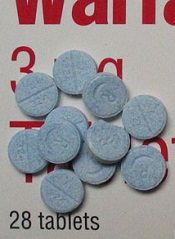
SAN FRANCISCO—Monitoring warfarin using a modified prothrombin time (PT) test can improve anticoagulation stability and long-term clinical outcomes, result of the Fiix trial suggest.
With Fiix-PT—a test that only measures the activity of coagulation factors II and X—the effect of warfarin fluctuated less than with standard PT.
Fiix-PT also proved superior in reducing long-term, recurrent thromboembolism (TE), and it did not increase bleeding, despite the fact that the test omits factor VII activity.
However, most of these effects occurred only after the 6-month mark.
Pall T. Onundarson, MD, of Landspitali University Hospital and University of Iceland School of Medicine in Reykjavik, presented these results at the 2014 ASH Annual Meeting (abstract 347).
Dr Onundarson is a co-inventor of the Fiix-PT test and has stock in Fiix Diagnostics, a startup company with the two inventors of the test as majority shareholders.
“Why would anyone still be interested in warfarin in 2014,” Dr Onundarson asked the audience at ASH. “Even if warfarin is very efficacious . . ., managing warfarin is trouble. The dose varies between patients, and the main problem is that we have a fluctuating or unstable effect—namely, a fluctuating INR—and this leads to frequent dose adjustments and frequent testing.”
Dr Onundarson said the common wisdom is that the effect of warfarin fluctuates due to food interactions and drug interactions. But he and his colleagues speculated that the fluctuation is partly caused by conventional PT.
They noted that experiments have suggested the anticoagulation effect of warfarin is mainly influenced by a reduction in FII and FX activity, and FVII may have relatively little effect. Due to the short half-life of FVII and its strong influence on the PT, monitoring warfarin using PT may confound dosing.
With that in mind, the Fiix-PT test was designed to measure only the activity of FII and FX. And the researchers conducted the Fiix trial to compare Fiix-PT and conventional PT.
Their study included 1148 patients—573 in the Fiix-PT arm and 575 in the PT arm. Overall, about 69% of patients had atrial fibrillation, and 21% had venous thromboembolism. The median monitoring time was 1.7 years per patient in both arms.
The researchers noted that most outcomes were not significantly different between the 2 arms in the first 6 months, but, after that point, things changed. So they examined outcomes after 6 months in a secondary analysis.
From day 1 to 180, there was no significant difference between the Fiix-PT arm and the PT arm in the number of dose changes per patient year (5.3 and 6.5, respectively, P=0.08). However, from day 181 to 720, there were significantly fewer dose changes in the Fiix-PT arm (4.1 and 5.0, respectively, P=0.01).
The researchers assessed the median time within target range (TTR) during 4 periods of the study, and, although results fluctuated, there were significant differences in favor of Fiix-PT.
The median TTR was 85% in the Fiix-PT arm and 81% in the PT arm for days 1 to 180 (P=0.013); 85% and 90%, respectively, for days 181 to 360 (P<0.0003); 80% and 81%, respectively, for days 361 to 540 (P=0.34); and 87% and 79%, respectively, for days 541 to 720 (P<0.005).
Overall, there was no significant difference in the rate of TE or major bleeding between the Fiix-PT and PT arms. However, when the researchers excluded the first 6 months of observation, they noted a significant difference in the rate of TE in favor of Fiix-PT.
In the primary analysis (encompassing days 1 to 720), the TE rate per patient year was 1.2% in the Fiix-PT arm and 2.3% in the PT arm (P=0.09 for superiority, P<0.001 for non-inferiority). The major bleeding rates were 2.2% and 2.5%, respectively (P=0.8 for superiority, P<0.001 for non-inferiority).
In the secondary analysis (from day 181 to 720), Fiix-PT led to a superior long-term reduction in TE compared to conventional PT—1.1% and 2.2%, respectively (P=0.03 for superiority). But there was no significant difference in the rates of major bleeding—1.5% and 2.3%, respectively (P=0.5 for superiority).
“Compared to high-quality PT-INR monitoring, Fiix-PT increased the stability of warfarin anticoagulation,” Dr Onundarson said in closing. “Fiix-PT was clinically at least non-inferior to the INR in the primary analysis, and Fiix-PT led to superior long-term reduction in TE in the secondary analysis. Fiix-PT did not increase major bleeding, despite lowering the long-term thromboembolic rate and despite not being affected by FVII in the test sample.”
“So my overall conclusion is that a fluctuating INR during warfarin treatment is partly a confounding side effect of the PT itself. The data suggests that, if the PT is replaced with a monitoring test that is not affected by FVII, warfarin may become more stable than was previously assumed.”


